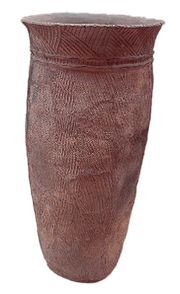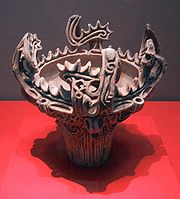
Jomon Pottery
Encyclopedia


Jomon period
The is the time in Japanese prehistory from about 14,000 BC to 300 BC.The term jōmon means "cord-patterned" in Japanese. This refers to the pottery style characteristic of the Jōmon culture, and which has markings made using sticks with cords wrapped around them...
in Japan
Japan
Japan is an island nation in East Asia. Located in the Pacific Ocean, it lies to the east of the Sea of Japan, China, North Korea, South Korea and Russia, stretching from the Sea of Okhotsk in the north to the East China Sea and Taiwan in the south...
. The term "Jōmon" (縄文) means "rope-patterned" in Japanese, describing the patterns that are pressed into the clay.
Oldest Pottery in the World
The pottery vessels crafted in Ancient Japan during the Jōmon period are generally accepted to be the oldest in the world. They are not, however, the oldest ceramic objects, which are figurines such as the Venus of Dolní VěstoniceVenus of Dolní Vestonice
The Venus of Dolní Věstonice is a Venus figurine, a ceramic statuette of a nude female figure dated to 29,000–25,000 BCE , which was found at a Paleolithic site in the Moravian basin south of Brno.-Description:...
discovered in what is today the Czech Republic .
Dating
Bits of pottery discovered in a cave in the northwest coast of modern day Kyushu date back to as far as 12,700 BCE in radiometric dating tests . It is believed by many that Jōmon pottery was probably made even earlier than this date. However, due to ambiguity and multiple sources claiming different dates based on different dating techniques, it is difficult to say for sure how far back Jōmon Pottery was made. Some sources claim archaeological discoveries as far back as the 14th millennium BCE .Jōmon Chronology
The Jōmon Period in Ancient Japan lasted until roughly 300 BCE. From there, it is divided into six periods: Incipient Jōmon, from 10,500-8,000 BCE, Earliest Jōmon, from 8,000-5,000 BCE, Early Jōmon, from 5,000-2,500 BCE, Middle Jōmon, from 2,500- 1,500 BCE, Late Jōmon, from 1,500-1,000 BCE, and Final Jōmon, from 1,000-300 BCE . There are over 80 sites in Japan where Incipient Jōmon pottery vessels have been found , but the majority of Jōmon pottery remains come from the later periods.Characteristics
The majority of Jōmon pottery has rounded bottoms and the vessels are typically small. This shows that the vessels would typically be used to boil food, perhaps fitting into a fire . Later Jōmon pottery pieces are more elaborate, especially during the Middle Jōmon period, where the rims of pots became much more complex and decorated .The name Jōmon itself means “rope-patterned”. This refers to the impressions on the surface of the pottery which were created by pressing rope into the clay before it was heated to approximately 600-900 degrees Celsius. .
See also
- Corded Ware cultureCorded Ware cultureThe Corded Ware culture , alternatively characterized as the Battle Axe culture or Single Grave culture, is an enormous European archaeological horizon that begins in the late Neolithic , flourishes through the Copper Age and culminates in the early Bronze Age.Corded Ware culture is associated with...
, a prehistoric European culture also characterised by pottery with cord and rope impressions

